To visit - Venice
Venice, a city of unreal beauty, invites you to marvel at its winding canals, elegant palaces, and iconic bridges. Every corner, every cobblestone alley, reveals a centuries-old story, making Venice a journey through time.
Enchanting Canals: Explore the Venetian canals by gondola or vaporetto, and let yourself be carried along the colorful facades of historic palaces. The Grand Canal, the main waterway, is lined with architectural masterpieces, witnesses to the wealth and refinement of the Republic of Venice.
St. Mark's Square, an Open-Air Theatre: The majestic St. Mark's Square is the heart of Venetian social life. Admire the Basilica di San Marco with its golden domes, the towering campanile dominating the skyline, and the elegant cafes inviting contemplation.
Iconic Bridges: Crossing the centuries-old Rialto Bridge is a must. The views from this historic bridge provide a picturesque tableau of Venetian daily life.
Mysterious Alleys: Lose yourself in the labyrinth of narrow streets, where each corner hides hidden treasures. From discreet churches to artisan workshops, every passage is a discovery.
The Venice Biennale, an Artistic Feast: Immerse yourself in the world of contemporary art at the Venice Biennale, a global event that transforms the city into an open-air gallery, adding a modern dimension to its artistic heritage.
Lagoon Islands: Explore neighboring islands like Murano, famous for its glassmaking, and Burano, with its vibrant, multicolored houses. Each offers a unique glimpse into Venetian craftsmanship.
Venice Carnival, a Fairy-Tale Celebration: Dive into the magical atmosphere of the Venice Carnival, where masks and elaborate costumes transform the city into a living tableau of the Baroque era.
Venice, with its timeless charm and theatrical ambiance, is more than just a tourist destination; it's an immersive experience, a romantic odyssey where every moment feels like it's lifted from a fairy tale floating on the crystalline waters of the lagoon.
The 9 essential things to do in Venice :
Summary
1 - Explore the canals by gondola
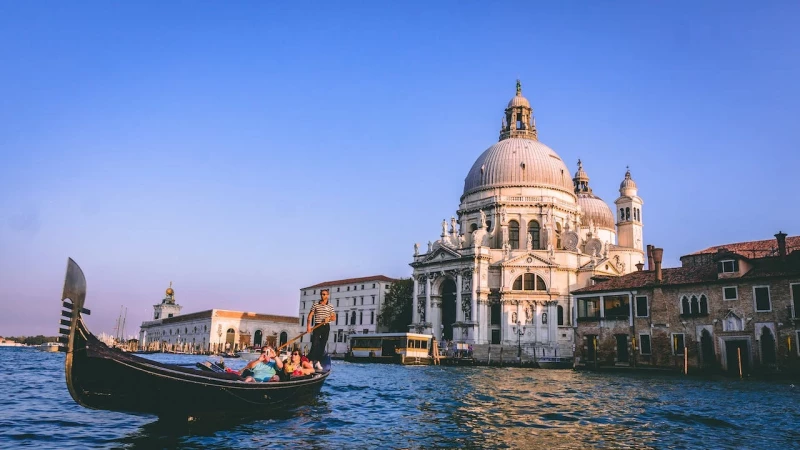
Exploring the canals of Venice in a gondola is an iconic and romantic experience. Here's what you can expect during a gondola ride:
-
Romantic Atmosphere: Gondolas are often associated with romance. Whether you're traveling as a couple, with family, or solo, the peaceful ambiance of the Venetian canals creates a special atmosphere.
-
Unique Perspectives: The view from a gondola provides unique perspectives of Venetian buildings, bridges, and alleys. It's an excellent opportunity to capture memorable photos.
-
Navigating the Canals: Skillfully trained gondoliers will guide you through the narrow canals of the city. It's an immersive experience that allows you to see Venice in a different light.
-
Traditional Music: Some gondoliers may sing traditional Italian songs during your ride, adding to the magical atmosphere. Be sure to inquire with the gondolier beforehand to see if this is an option.
-
Exploration of Hidden Corners: Gondoliers are familiar with the city and can take you through less frequented areas, allowing you to discover more intimate and tranquil aspects of Venice.
-
Scheduling and Pricing: The cost of gondola rides can vary, so be sure to negotiate the price before boarding. Prices may be higher in the evening or in highly touristy areas like St. Mark's Square.
Enjoy every moment during your gondola ride in Venice, as it is an integral part of the unique experience this city offers to its visitors.
 Our tips for getting the most out of your experience.
Our tips for getting the most out of your experience.
Exploring the canals of Venice in a gondola is an unforgettable experience. Here are some tips to make this adventure even more enjoyable:
-
Negotiate the price in advance: Gondola ride prices are not fixed, so feel free to negotiate with the gondolier before boarding. Make sure to clarify the duration of the ride to avoid any confusion.
-
Avoid crowded tourist spots: Areas around St. Mark's Square can be very busy. If you prefer a more peaceful experience, ask the gondolier to take you to less touristy canals.
-
Choose the right time of day: Gondola rides are often more romantic in the evening when the light is soft. Avoid peak hours for a quieter experience.
-
Share a gondola: Gondola rides can be pricey, but you can reduce costs by sharing a gondola with other visitors. It's also a great opportunity to meet new people.
-
Bring a water bottle: Gondola rides can be quite long, especially if you opt for an extended duration. Bring a water bottle to stay hydrated during the ride.
-
Ask the gondolier for information: Gondoliers are often well-informed local residents. Don't hesitate to ask them questions about the history of Venice, the best places to visit, or even their favorite songs.
-
Be prepared to pay in cash: Most gondoliers prefer to be paid in cash. Make sure to have some currency with you before boarding.
-
Opt for a longer ride: If your budget allows, consider a longer gondola ride. This gives you more time to soak in the unique atmosphere of the canals.
-
Respect the maximum weight: Gondolas have a maximum weight capacity. Ensure that you adhere to this limit, especially if you are sharing the gondola with others.
-
Be mindful of the weather: Weather conditions can impact your experience. If possible, choose a day with fair weather to fully enjoy the ride.
Enjoy every moment during your gondola ride in Venice, and let yourself be swept away by the beauty and romance of this unique experience.
2 - Saint Mark's Basilica
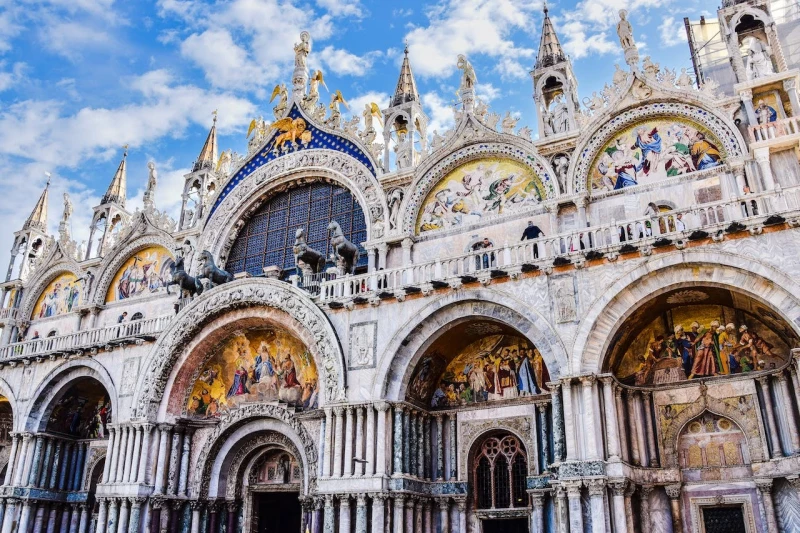
The Basilica of St. Mark, located on St. Mark's Square in Venice, is one of the most iconic landmarks of the city. Here are some essential details about this magnificent basilica:
-
History: Construction of the Basilica of St. Mark began in the 9th century. It was erected to house the relics of Saint Mark, the evangelist, which had been brought to Venice from Alexandria. The basilica has undergone several renovations over the centuries.
-
Architecture: The basilica is a remarkable example of Byzantine architecture with Venetian and Italian influences. It features five impressive domes, arches, columns, and a richly decorated facade.
-
Mosaics: The interior of the basilica is adorned with stunning mosaics covering an impressive area. These mosaics depict biblical scenes, saints, and religious events. The mosaics are primarily made of gold, creating a luminous atmosphere inside the basilica.
-
Pala d'Oro: The Pala d'Oro is a gold and enamel altarpiece that adorns the high altar. It is considered an exceptional work of goldsmithing, with thousands of embedded precious stones.
-
Horses of Saint Mark: The famous Horses of Saint Mark, once located outside the basilica, are now preserved inside to protect them from the elements. They are ancient sculptures of great artistic value.
-
The Loggia: The loggia is an elevated outdoor gallery that offers a magnificent view of St. Mark's Square. It is an ideal spot to admire the architecture of the basilica and its surroundings.
-
St. Mark's Campanile: Adjacent to the basilica is St. Mark's Campanile, the iconic bell tower of Venice. Visitors can climb to the top to enjoy a panoramic view of the city.
-
Treasury of the Basilica: The basilica houses a treasury containing relics, liturgical objects, and goldsmith works, reflecting the richness of its history.
-
Practical Visit: Entry to the basilica is free, but there are fees to access certain areas such as the treasury or the museum. It is recommended to dress appropriately (covering shoulders and knees) to enter the basilica.
The Basilica of St. Mark is an artistic and spiritual treasure that attracts visitors from around the world. A visit to the basilica offers a fascinating dive into the history and culture of Venice.
 Our tips for getting the most out of your experience.
Our tips for getting the most out of your experience.
Visiting the Basilica of St. Mark in Venice is a unique cultural and artistic experience. Here are some tips to make your visit more enjoyable and enriching:
-
Arrive early in the morning: The basilica is a popular attraction, especially during peak times. By arriving early in the morning, you can avoid crowds and enjoy a quieter atmosphere.
-
Book in advance: If you plan to visit specific areas of the basilica, such as the treasury or the museum, consider booking your tickets in advance to skip the lines.
-
Dress appropriately: Ensure you dress appropriately. Shoulders and knees must be covered to enter the basilica. Wearing inappropriate clothing may result in being denied entry.
-
Explore different areas: The basilica has several sections, including the central nave, galleries, treasury, and museum. Take the time to explore each part to fully appreciate the artistic and historical richness of the building.
-
Look up: The ceiling mosaics are among the highlights of the basilica. By looking up, you'll discover amazing details that are worth admiring.
-
Take a guided tour or use an audio guide: A professional guide or an audio guide can provide detailed information about the history, architecture, and artworks in the basilica. This can enhance your experience.
-
Admire the Pala d'Oro: Don't miss the gold altarpiece, the Pala d'Oro, located behind the high altar. It's an exceptional piece of art with inlaid gemstones.
-
Respect the sacred nature: As the Basilica of St. Mark is an active place of worship, make sure to respect prayer and moments of reflection. Turn off your cellphone and speak in a low voice.
-
Take time to meditate: With its beauty and spiritual atmosphere, the basilica provides a conducive setting for meditation. Find a bench or a quiet corner to absorb the unique atmosphere.
-
Enjoy St. Mark's Square: After your visit, take the time to relax in St. Mark's Square, surrounded by magnificent architecture and a vibrant atmosphere.
By following these tips, you can fully enjoy your visit to the Basilica of St. Mark and learn more about the history and art of this iconic place.
3 - St. Mark's Square
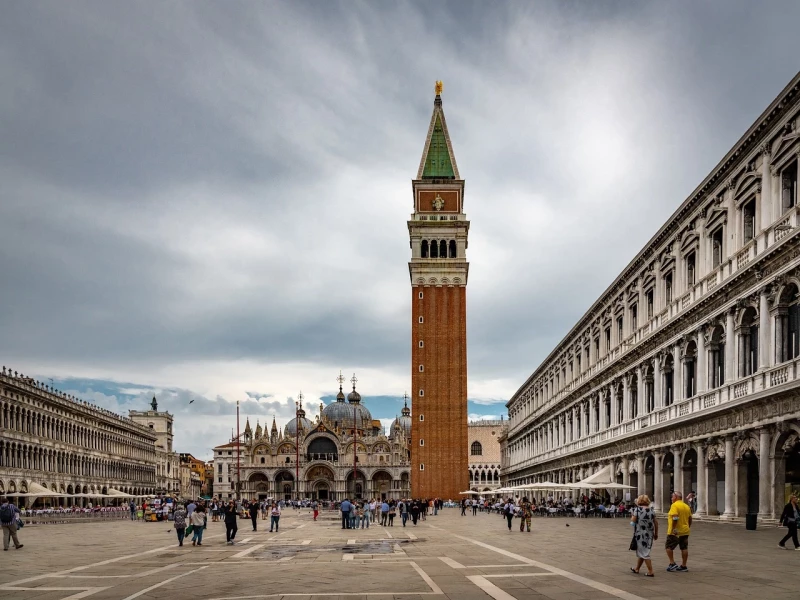
Saint Mark's Square, situated in the heart of Venice, stands as one of the most iconic squares worldwide. Surrounded by historical landmarks, it offers a journey through Byzantine, Gothic, and Renaissance architecture.
Dominating the square is the Basilica of Saint Mark, adorned with domes and golden mosaics, housing the relics of Saint Mark. Adjacent to it, the Campanile provides a unique panoramic view of the city.
The Doge's Palace, once the residence of Venetian doges, showcases impressive Gothic architecture. Next to it, the Clock Tower captivates with its astronomical clock.
Historic cafes line the square, including Café Florian, one of Europe's oldest. The square serves as a venue for various cultural events and festivals.
Occasionally subject to flooding, the square takes on a romantic allure during "acqua alta," with temporary walkways facilitating passage.
Despite tourist crowds, the square retains a magical atmosphere. Early mornings or late evenings unveil its full splendor.
Symbolizing Venice, Saint Mark's Square embodies the city's history, art, and social life. A must-visit for any explorer of the City of Canals.
 Our tips for getting the most out of your experience.
Our tips for getting the most out of your experience.
Visiting St. Mark's Square in Venice can be an extraordinary experience. Here are some tips to make your visit more enjoyable and enriching:
-
Arrive early in the morning: St. Mark's Square is less crowded early in the morning. By arriving early, you can avoid crowds and enjoy the beauty of the square in a quieter setting.
-
Explore the basilica at opening: If you plan to visit the Basilica of St. Mark, try to enter early in the day to avoid the long lines that form later in the day.
-
Book in advance: If you intend to visit specific attractions like the Campanile or the Doge's Palace, consider booking your tickets in advance to skip the lines.
-
Opt for a guided tour: A guided tour can provide you with in-depth information about the history of the square and its monuments. Guides may also grant you access to special areas.
-
Climb to the top of the Campanile: For a spectacular view of Venice, don't forget to climb to the top of the Campanile. The panoramas from this iconic tower are breathtaking.
-
Relax in a café: The historic cafes on the square offer a unique atmosphere. Take the time to relax, enjoy a coffee, and observe life unfolding around you.
-
Enjoy outdoor music: Some cafes offer outdoor music. Sit back, relax, and enjoy musical performances while admiring the grand architecture.
-
Be aware of high tides: The square can be flooded during high tides. Wear appropriate footwear and be aware of weather forecasts to avoid surprises.
-
Explore the surrounding alleys: The square is surrounded by charming alleys. Take the time to explore less crowded areas to discover hidden corners of Venice.
-
Capture the moment: Don't forget to bring your camera. St. Mark's Square offers numerous opportunities to capture memorable moments.
-
Respect the rules of the basilica: When visiting the Basilica of St. Mark, make sure to adhere to the dress code, covering shoulders and knees.
-
Beware of scams: Be cautious of street vendors and tourist scams. Stay vigilant to avoid any issues.
By following these tips, you can maximize your experience on St. Mark's Square and fully appreciate everything it has to offer.
4 - The Doge's Palace
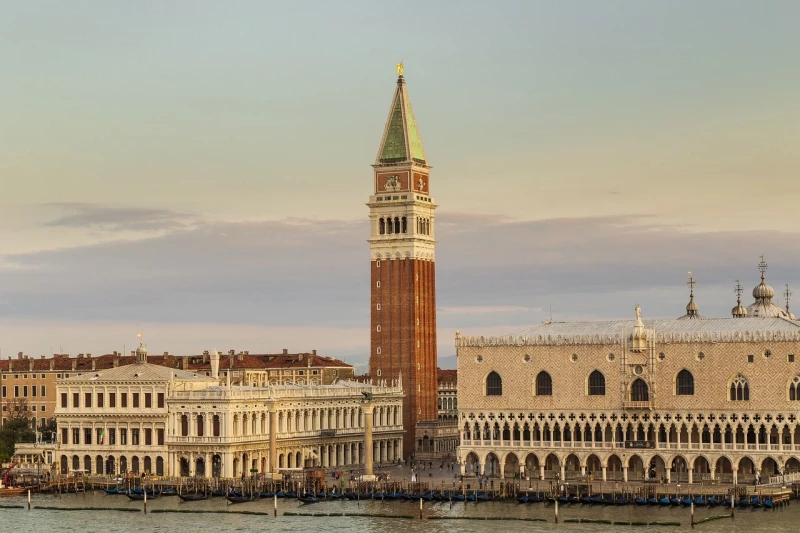
The Doge's Palace, an architectural treasure in Venice, majestically graces St. Mark's Square. This masterpiece of Venetian Gothic architecture served as the seat of the government of the Republic of Venice for centuries.
Adorned with elaborate arcades and refined details, the palace houses the Grand Council Chamber, renowned for its impressive size and Tintoretto's breathtaking frescoes, including the "Paradise."
The Bridge of Sighs, connecting the palace to the prisons, evokes the somber fate of condemned prisoners. The Halls of Arms and Maps showcase Venice's maritime power through ancient maps and coats of arms.
The prisons, witnesses of a bygone era, add an intriguing dimension to the visit, revealing austere conditions and a complex labyrinth of cells.
Guided tours offer an immersive experience in the palace's history and art, while current cultural events perpetuate its vibrancy.
Combined tickets often grant access to multiple sites, providing a comprehensive experience of the historical and artistic richness of the Doge's Palace.
 Our tips for getting the most out of your experience.
Our tips for getting the most out of your experience.
Visiting the Doge's Palace in Venice can be a captivating experience. Here are some tips to make your visit more enjoyable and enriching:
-
Buy your tickets in advance: To avoid long lines, consider purchasing your tickets online in advance. This will also allow you quicker access to the palace.
-
Opt for a guided tour: A guide can provide in-depth information about the history, architecture, and artworks of the Doge's Palace. This can enhance your experience and provide interesting perspectives.
-
Explore the different rooms: The palace houses various fascinating rooms, including the Grand Council Chamber, the prisons, and the Doge's apartments. Take the time to explore each section for a comprehensive experience.
-
Admire the artworks: The Doge's Palace houses an impressive collection of artworks, including frescoes by Tintoretto and Veronese. Take the time to admire these artistic treasures.
-
Don't miss the Bridge of Sighs: The famous Bridge of Sighs connects the palace to the prisons. Make sure to see it and understand its romantic and melancholic history.
-
Check the opening hours: Make sure you know the opening hours of the Doge's Palace, as well as any closures for special events. Plan your visit accordingly.
-
Enjoy views from the windows: Some parts of the palace offer beautiful views of the Venetian lagoon and the city. Be attentive to windows and panoramic viewpoints.
-
Respect the palace rules: Some areas of the palace may have strict rules, including regarding photography and behavior. Make sure to respect these rules for a trouble-free visit.
-
Check out temporary exhibitions: The Doge's Palace sometimes hosts temporary exhibitions. Check the cultural program to see if there are any special events during your visit.
-
Avoid peak hours: For a more peaceful experience, avoid peak hours and the busiest days. Visiting early in the morning or late in the day can be more enjoyable.
By following these tips, you'll be better prepared to fully appreciate the history, art, and architecture of the Doge's Palace during your visit to Venice.
5 - Get lost in the streets
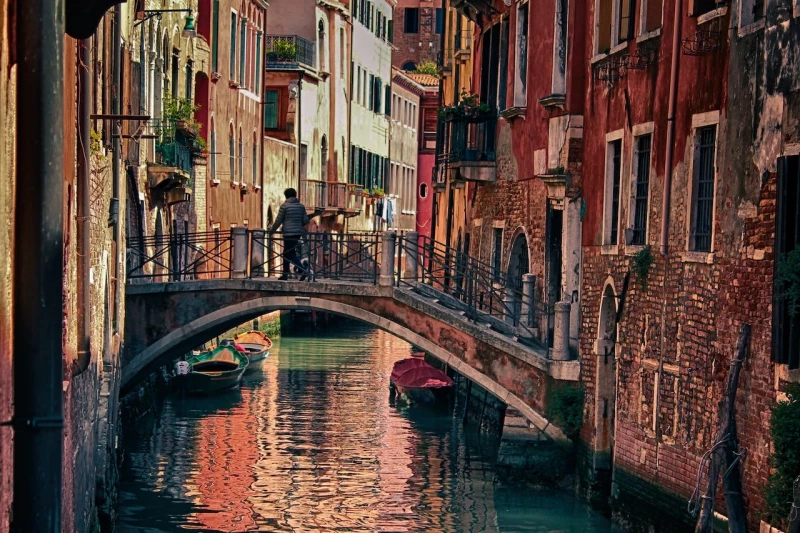
Deliberately lose yourself in the narrow streets of Venice for an authentic and immersive experience. Let your curiosity be your guide and explore the labyrinthine alleys without a precise itinerary, allowing surprises to unfold naturally.
Avoid crowded tourist areas and delve into less-explored neighborhoods to discover the true essence of Venetian life. Lose track of time as you stroll without haste, soaking in the unique atmosphere of the city.
Admire urban art adorning some alleys, from murals to creative installations, revealing Venice's hidden creativity. Observe architectural details, from richly adorned facades to picturesque bridges, with each element telling a fascinating story.
Explore the alleys at night for a magical experience, with soft lights illuminating the canals and creating an enchanting ambiance. Meet locals in less-frequented areas, engaging in spontaneous conversations and discovering local life.
Be ready to get lost and venture into unexpected places, knowing that each detour holds a discovery. Follow the gentle lapping of the water to find peaceful and picturesque corners, adding a sonic dimension to your exploration.
Bring a map for orientation, although getting lost is part of the experience, a map can be useful for finding your way back. By deliberately getting lost, you'll uncover the true splendor of Venice off the beaten path.
 Our tips for getting the most out of your experience.
Our tips for getting the most out of your experience.
Deliberately get lost in the narrow streets of Venice with these tips for an immersive and memorable experience:
-
Leave the map behind: To truly get lost, ditch the map. This will force you to rely more on your senses and fully immerse yourself in the surroundings.
-
Follow the locals: If you spot locals, feel free to follow them. They often know lesser-known routes and can lead you to hidden gems.
-
Change direction randomly: When you reach a crossroads, choose a direction at random. This ensures a random exploration, leading to unexpected discoveries.
-
Trust your instincts: If a particular alley appeals to you, follow your instincts. Intuitive exploration can often lead you to unique places.
-
Avoid main routes: Stay away from the busiest paths. Lesser-known alleys are often quieter and offer a more authentic experience.
-
Explore early morning or late evening: Early morning and evenings are ideal for getting lost without the crowds. It's also when the lighting adds a special atmosphere to the city.
-
Wear comfortable shoes: Alleys can be paved and narrow. Comfortable shoes make walking easier and allow you to venture into hard-to-reach corners.
-
Photograph landmarks: Take photos of memorable landmarks to help you find your way later, but only use them if absolutely necessary to maintain the sense of discovery.
-
Allow free time: Don't plan too many activities in the day to have enough time to get lost. The goal is to savor every corner.
-
Strike up conversations: If you're lost, don't hesitate to ask locals for directions. This can lead to authentic local interactions.
-
Observe small details: Architectural details, small markets, and unique features of the alleys deserve special attention. Take the time to appreciate them.
-
Stay safe: While adventure is the goal, make sure to remain aware of your surroundings and avoid venturing into poorly lit or potentially unsafe areas.
By following these tips, you'll turn your stroll through the alleys of Venice into an authentic and surprise-filled exploration.
6 - Discover the Rialto Bridge
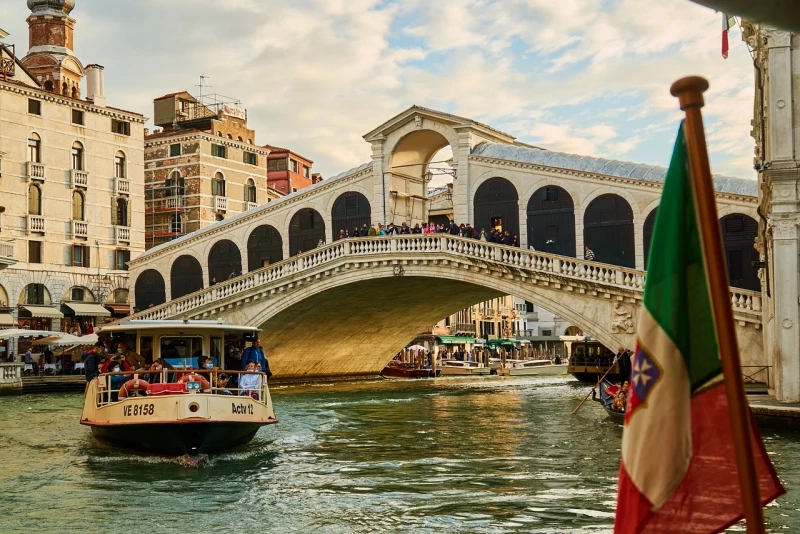
The Rialto Bridge in Venice, one of the city's most iconic landmarks, provides a captivating experience. Spanning the Grand Canal, it connects the lively districts of San Marco and San Polo, serving as a central hub in Venetian life.
Built in the 16th century, the bridge features remarkable arches and sculptural details, showcasing the architectural brilliance of the time. Historically associated with commerce and prosperity, the Rialto Bridge was a vital crossing point for merchants, contributing to the wealth of the Venetian Republic.
Lining both sides of the bridge, charming shops offer a variety of goods, creating a bustling atmosphere with everything from souvenirs to artisanal items. Ascending the bridge rewards visitors with a spectacular view of the Grand Canal, providing glimpses of the constant activity of gondolas, vaporettos, and boats.
Watching the sunset from the bridge is an unforgettable experience, with golden light embracing the shores of the Grand Canal. The Rialto Bridge often hosts special events and festivals, adding a festive dimension to its daily role as a crucial passage.
Its beauty and distinctive atmosphere have been immortalized on screen in various films, enhancing its iconic status. Due to its global renown, the bridge attracts a large number of visitors. For a quieter experience, exploring it early in the morning or late in the evening is recommended.
As a silent witness to Venetian history, the Rialto Bridge embodies the cultural heritage of Venice, reminding us of the city's significance as a commercial and artistic center over the centuries.
 Our tips for getting the most out of your experience.
Our tips for getting the most out of your experience.
Discovering the Rialto Bridge in Venice can be a rewarding experience. Here are some tips to make the most of your visit:
-
Visit Early Morning or Late Evening: To avoid crowds, plan your visit early in the morning or late in the evening. This allows you to appreciate the beauty of the bridge in a more peaceful atmosphere.
-
Explore Surrounding Alleys: The alleys around the Rialto Bridge are full of charm. Take the time to explore the nearby neighborhoods to discover hidden gems and escape the tourist hustle.
-
Enjoy the View from the Bridge: Climb onto the bridge to enjoy a magnificent view of the Grand Canal. It's an excellent spot for capturing memorable photos of Venice.
-
Discover Traditional Shops: The shops along the bridge offer a variety of products. Explore them to find unique souvenirs and artisanal items.
-
Take a Vaporetto: For a different perspective, take a vaporetto (Venetian water bus) and observe the Rialto Bridge from the water. It's a picturesque way to experience this Venetian icon.
-
Learn the History: Familiarize yourself with the history of the bridge before your visit. This will enhance your experience by understanding the historical and cultural role it has played in the city.
-
Join a Guided Tour: Participate in a guided tour to gain in-depth information about the architecture and history of the bridge. Guides can provide fascinating details.
-
Be Aware of Pickpockets: As is often the case in tourist areas, remain vigilant about your belongings to avoid any pickpocketing issues.
-
Avoid Peak Hours: If possible, avoid visiting the bridge during peak hours. This ensures a more relaxed and enjoyable experience.
-
Take Your Time: Don't rush. Take the time to admire the architecture, watch gondolas pass by, and soak in the unique atmosphere surrounding the Rialto Bridge.
By following these tips, you'll be better prepared to fully enjoy your discovery of the Rialto Bridge and its surroundings in Venice.
7 - Visit the lagoon islands
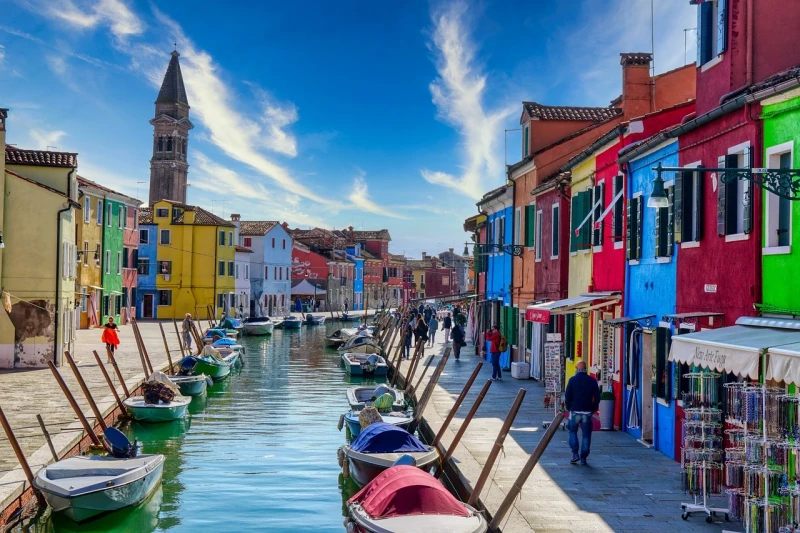
Exploring the islands of the Venetian Lagoon provides a unique getaway. You can start with Murano, renowned for its glassblowing, then explore the colorful houses of Burano. Torcello, rich in history, houses the Santa Maria Assunta cathedral.
Lido, famous for its beaches, also hosts film festivals. Giudecca offers a tranquil atmosphere with churches and a panorama of the San Marco basin. San Giorgio Maggiore provides a panoramic view and peaceful gardens.
Explore these islands while avoiding crowds, savor local seafood, use vaporettos for transportation, and discover local daily life. End the day by capturing a stunning sunset from the Lido beach, offering a spectacular view of the lagoon. By exploring these islands, you'll discover the cultural, artistic, and culinary diversity that characterizes the beautiful Venetian Lagoon.
 Our tips for getting the most out of your experience.
Our tips for getting the most out of your experience.
For a successful visit to the islands of the Venetian Lagoon, here are some tips to consider:
-
Plan your itinerary: Identify the islands you want to visit and plan your route based on your preferences.
-
Start early in the morning: To avoid crowds and enjoy a more peaceful atmosphere, begin your visit early in the morning.
-
Explore Murano before the crowds: If you plan to visit Murano, known for its glassblowing, arrive early to appreciate demonstrations without the crowds.
-
Allocate extra time for Burano: The island of Burano, famous for its colorful houses, deserves additional time to wander through its picturesque alleys.
-
Opt for vaporettos: Use vaporettos to move conveniently between the islands and enjoy unique views from the water.
-
Explore less touristy islands: In addition to Murano and Burano, discover less frequented islands like Torcello for a more authentic experience.
-
Be prepared to walk: Many islands are best explored on foot. Ensure you have comfortable shoes for walking on cobblestone streets.
-
Enjoy local cuisine: Sample local specialties on each island. Seafood in Burano and traditional dishes in Torcello are worth trying.
-
Be aware of ferry schedules: Check ferry schedules to avoid long waits and optimize your exploration time.
-
Avoid peak hours: For a quieter experience, steer clear of tourist peak hours and favor quieter times of the day.
-
Admire local architecture: Each island has distinct architecture. Take time to admire the details of churches, houses, and squares.
-
Capture the essence of each island: Beyond tourist attractions, try to capture the unique essence of each island by mingling with local life.
With these tips, your exploration of the islands of the Venetian Lagoon will be more enjoyable and memorable.
8 - Attend an opera performance or concert
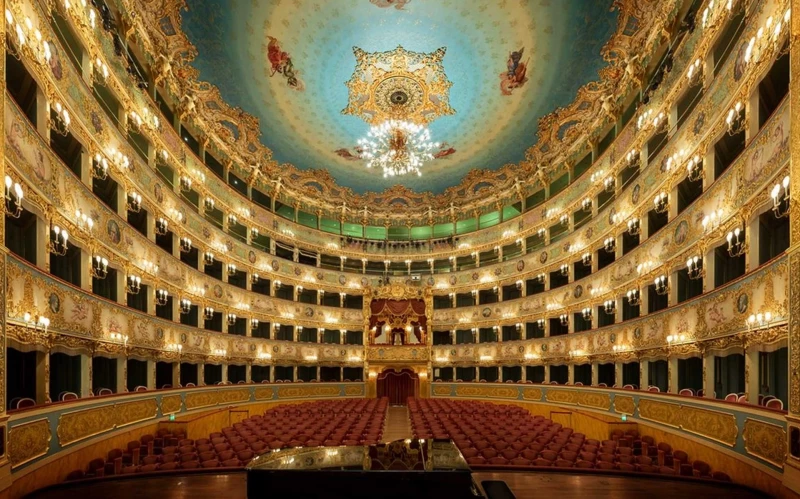
Attending an opera or concert in Venice is an immersion into the city's cultural richness. Opt for iconic venues like La Fenice for opera or historic churches for concerts, creating a unique atmosphere. Ensure to book tickets in advance, especially during peak tourist periods, to secure your spot and be mindful of any dress code.
Arrive early to soak in the atmosphere and explore the surroundings. Choose productions that highlight Venice's musical heritage, featuring works by local composers like Vivaldi. Concerts in churches provide exceptional acoustics and an intimate musical experience. Show respect during the performance by maintaining silence and turning off electronic devices.
After the show, some performances offer opportunities to meet the artists, providing a chance to discuss their art. Explore ongoing music festivals during your stay for a diverse range of artists and genres. Round off your evening with a gastronomic experience by booking a table at an elegant restaurant for a complete immersion into Venetian culture. Experience a memorable musical evening, infused with the history and artistic richness of Venice.
 Our tips for getting the most out of your experience.
Our tips for getting the most out of your experience.
To make the most of your experience attending an opera or concert in Venice, consider the following tips:
-
Choose your performance wisely: Select an opera or concert that aligns with your musical and artistic preferences. Venice offers a diverse range of options, from classical to more contemporary performances.
-
Book your tickets in advance: Venetian shows can be popular, especially during peak tourist seasons. Ensure you book your tickets in advance to secure your spot.
-
Familiarize yourself with the venue: Some performances take place in iconic venues like La Fenice. Get to know the location to enhance your overall experience.
-
Check the dress code: Certain venues may have a formal dress code. Check in advance to dress appropriately for the occasion.
-
Arrive early for a better seat: Arrive early to have a better selection of seats and to soak in the pre-performance atmosphere.
-
Explore the surroundings: If the performance is in a historically rich area, take the opportunity to explore the surroundings before the show.
-
Turn off electronic devices: Show respect for the performers and fellow audience members by turning off your phone and other electronic devices during the performance.
-
Pay attention to intermissions: If the show includes intermissions, take advantage of the breaks to relax and appreciate the venue's atmosphere.
-
Take advantage of post-show meetups: Some productions offer opportunities to meet the artists after the performance. It's a great chance to discuss the show and gain insights.
-
Explore nearby dining options: Plan to have dinner at a local restaurant after the performance to extend the cultural experience.
By following these tips, you can maximize your enjoyment during an opera or concert in Venice, adding an unforgettable touch to your stay in the city.
9 - Enjoy Venetian cuisine
To savor Venetian cuisine, prioritize local experiences. Explore less touristy neighborhoods to discover authentic trattorias. Taste regional specialties like sarde in saor, fegato alla veneziana, or cicchetti. Try fresh seafood, often featured in dishes like spaghetti alle vongole or risotto ai frutti di mare. Don't miss out on the sweet delights of Venetian pastries, such as zaeti or fritelle.
For a complete immersion, sip on a spritz, the quintessential Venetian aperitif. Ask locals for recommendations to find culinary gems less frequented by tourists. Explore local markets, such as the Rialto Market, for fresh produce and gastronomic souvenirs.
Respect local meal times for a more authentic experience. By following these tips, you can fully savor the richness of Venetian cuisine and create memorable culinary experiences.
 Our tips for getting the most out of your experience.
Our tips for getting the most out of your experience.
To fully appreciate Venetian cuisine, here are some tips to consider:
-
Explore local neighborhoods: Avoid touristy areas and explore less frequented neighborhoods to discover authentic trattorias and restaurants.
-
Ask for recommendations: Consult locals or the staff at your accommodation for recommendations on the best places to enjoy authentic Venetian cuisine.
-
Opt for local dishes: Try regional specialties such as sarde in saor, fegato alla veneziana, cicchetti, spaghetti alle vongole, and other typical dishes.
-
Explore local markets: Visit local markets, like the Rialto Market, to discover fresh and authentic ingredients used in Venetian cuisine.
-
Sip on a spritz: Enjoy the classic Venetian aperitif, the spritz, to accompany your meal and savor a local experience.
-
Taste local wines: Pair your meal with local wines such as Prosecco to complement the Venetian culinary experience.
-
Explore small trattorias: Prioritize smaller, local trattorias over more touristy restaurants for a more authentic experience.
-
Try local pastries: Conclude your meal with traditional Venetian desserts like zaeti or fritelle.
-
Respect meal times: Italians have specific meal times, so try to have lunch between 12:30 and 14:30 and dinner between 19:30 and 22:00 for a more local experience.
-
Be open to experimentation: Don't hesitate to try new dishes and step out of your culinary comfort zone to discover unique flavors.
By following these tips, you can appreciate the richness and authenticity of Venetian cuisine, creating a memorable culinary experience during your stay in Venice.
Venice - Where to Stay?
Venice offers a variety of accommodation options, ranging from luxury hotels to more budget-friendly hostels. The choice of location often depends on personal preferences and budget. Here are some suggestions on where to stay in Venice:
-
San Marco: The San Marco district is at the heart of Venice, housing iconic sites such as St. Mark's Square, St. Mark's Basilica, and the Campanile. It's a central location, but it can be more expensive due to its popularity.
-
Castello: East of San Marco, Castello offers a more authentic and less touristy atmosphere. It's an excellent choice if you want to stay near the action while avoiding constant crowds.
-
Cannaregio: North of San Marco, Cannaregio is a residential neighborhood with a local atmosphere. Here, you'll find more affordable restaurants and shops while still being within walking distance of major sights.
-
Dorsoduro: This area is home to art galleries, impressive churches, and the University of Venice. It offers a relaxed atmosphere and is popular among students and visitors seeking a quieter experience.
-
Santa Croce: Located between Santa Lucia train station and San Marco, Santa Croce is a lively neighborhood with a mix of tourist attractions and everyday Venetian life.
-
Giudecca: An island across from St. Mark's Square, Giudecca offers beautiful views of Venice. It's a bit quieter and less crowded than the center of Venice.
-
Lido di Venezia: If you prefer to stay near the beach, Lido is an island accessible by vaporetto from the center of Venice. It offers a seaside atmosphere while providing easy access to the city.
Make sure to book in advance, especially during the high tourist season, to secure the best rates and availability. Explore online reviews to find accommodation that best suits your needs and travel style.
Venice - How to get around?
Getting around Venice, with its canals and narrow alleyways, is a unique experience. Here are some means of transportation in Venice:
-
Vaporetto (Water Bus): Vaporettos are the main form of public transportation in Venice. They operate on the Grand Canal and other wider canals, serving several stops at key locations. It's a convenient way to move around the city and enjoy views from the water.
-
Gondolas and Traghetti: Gondolas are iconic in Venice, but they are often used by tourists for romantic rides. Traghetti are ferries that cross the Grand Canal at certain points and can be a more economical option for crossing the canal.
-
Vaporetto dell'Arte: This service is a more luxurious version of the standard vaporetto, offering comfortable seating and art exhibitions on board. It follows a specific route along the Grand Canal.
-
Water Taxis: Water taxis are private boats available for direct trips to specific destinations. Although more expensive than vaporettos, they provide a faster and more personalized service.
-
Walking: Walking is one of the most enjoyable ways to explore Venice, especially in the historic center. Many tourist sites and popular neighborhoods are accessible on foot.
-
Ciclomotori Acquatici (Water Scooters): These small electric scooters are used for quick travel on the water, especially in narrower canals where vaporettos cannot access.
-
Bicycles: Although uncommon in Venice, some less crowded areas can be explored by bicycle. However, the historic center is mainly pedestrian.
It's important to note that Venice is a pedestrian city built on water, and motorized vehicles are limited. Public transportation by boat is essential for efficient movement throughout the city.
Venice - Best period
The best time to visit Venice depends on your preferences for climate, crowds, and activities. Here's an overview of the seasons in Venice:
-
Spring (March to May): Spring is often considered one of the best seasons to visit Venice. Temperatures are pleasant, days start to lengthen, and the city is less crowded than in summer. It's an ideal time for strolling through narrow streets, enjoying tourist attractions, and participating in local events.
-
Summer (June to August): Summer attracts a large number of visitors to Venice, especially in July and August. Temperatures can be high, and the city can be crowded. However, it's also a time for local festivities and cultural events.
-
Autumn (September to November): Autumn is another pleasant time to visit Venice. Temperatures are still mild, and while the number of tourists decreases compared to summer, the city remains lively. It's a favorable period for experiencing local life and enjoying the autumnal atmosphere.
-
Winter (December to February): Winter in Venice is quieter in terms of tourists, but temperatures can be cool. During the Christmas season and Carnival (January-February), the city takes on a special atmosphere with festive decorations and special events.
In summary, spring and autumn are generally considered the ideal seasons to visit Venice due to pleasant temperatures and fewer crowds compared to the peak summer season. However, if you enjoy festivals and the winter atmosphere, winter can also offer a unique experience.




